One of the wonderful things about barebow archery is the creativity it allows with respect to aiming. Without sight pins, your options are restricted only by your imagination. Even though many discussions on aiming systems give the impression we’re examining highly contrasting ideas, the differences are usually very subtle. For the most part, we’re talking about nothing more than how we utilize our sight picture—the information in front of our faces at full draw.
If you think about it, with very few exceptions we all pretty much have the same sight picture. In addition to the spot we’re trying to hit, it contains a number of secondary visual elements like the tip of our arrow, our sight window, a strike plate, and our bow’s shelf. If we shoot with an elevated rest and plunger button, those things are visible as well. The instinctive archer tries to block out everything in their sight picture except what they’re trying to hit. In contrast, conscious aiming utilizes one or more of those secondary visual elements, most commonly the tip of the arrow.
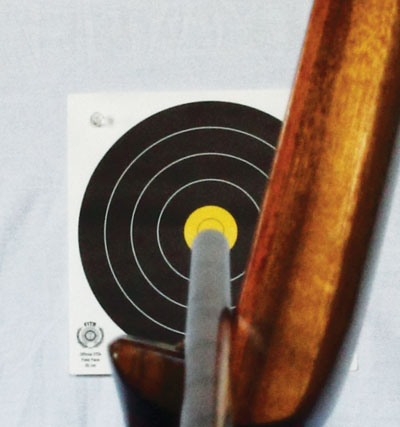
Point on distance is the distance at which you can hit something by aiming with the tip of your arrow directly on it at full draw.
Aiming systems utilizing the tip of the arrow revolve around something called the point-on distance. This is the distance at which the archer aims by visually placing the tip of the arrow at full draw directly on what they want to hit. For most bowhunters, their point-on distance is somewhere between thirty and sixty yards depending on a number of factors we’ll discuss later. At shorter distances they aim lower, bringing the tip of the arrow below their line of sight, which creates a visual gap between the target and the tip of the arrow—the gap that gap shooters use as an aiming reference.
Most hunting archers want their primary visual focus on the spot they’re trying to hit. That way they are immediately aware if the animal moves, and they can adjust accordingly. Since our eyes can only focus on one thing at a time, aiming with the tip of the arrow must take place in the peripheral vision.
This presents a significant issue that many would-be gap shooters fail to understand, unknowingly setting themselves up for failure. The farther an object is to the side of our primary vision, the harder it is to see in our peripheral vision. To illustrate this fact, look at the title on this magazine’s cover and focus your attention on the top of the lower-case “t” in Traditional. Without taking your eyes off that spot, you can probably read the “whu” in “Bowhunter” clearly in your peripheral vision. Now, without taking your eyes off the top of that lower-case “t”, try identifying words or objects at the bottom of the cover. If you can see them at all in your peripheral vision, they probably appear as random blurry images.
This is how our peripheral vision works, and it’s important to understand if we are going to use it for aiming. The closer an object is to where we’re looking (the spot we want to hit), the easier it is to see. So, if we are going to use the tip of our arrow in our peripheral vision as an aiming reference, we want it as close to our line of sight as possible. There are several ways to accomplish this.
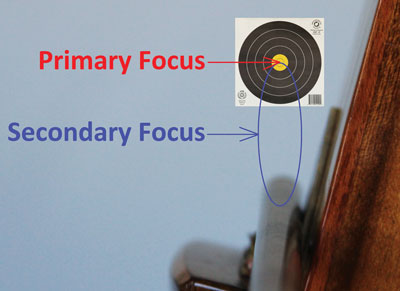
In gap shooting, your primary focus is on what you want to hit. The tip of the arrow and the gap are in your peripheral vision.
We can shoot slower, heavier arrows that will require us to aim higher, but slower arrows are more susceptible to distance estimation errors. While I understand we’re talking about bowhunting, not 3-D archery, accuracy is still important. Unless you presently shoot full length arrows, you could always switch to longer ones to make your gaps smaller. Of course, you’ll have to completely retune your setup, and in the end this change won’t really yield much in terms of results. By far the most effective way to get the tip of the arrow closer to your line of sight is by holding the back end of the arrow higher up your face, closer to your dominant eye. This is why most good close-range gap shooters hold the string with three fingers under the nock and utilize as high an anchor as possible.
When I first learned to shoot a bow, I was taught a split fingered hold on the string and to anchor with my index finger in the corner of my mouth. This put the back of the arrow very far below my eye. For all the years I aimed instinctively that hold and anchor worked well. But when I decided to learn gap shooting, it was a complete disaster. The tip of my arrow was so far below what I wanted to hit that, much like the words at the bottom of this magazine’s cover from our previous exercise, I couldn’t begin to see it clearly at full draw. I could see enough of my arrow to line up my windage, but it was so far below what I wanted to hit that I couldn’t set my elevation with any degree of accuracy. The end result was several months of frustrating shooting with plenty of high and low misses.
I can’t begin to count all the archers I’ve known over the years who approached gap shooting the same way I initially did and gave up, thinking the system was no good. Perhaps gap shooting really wasn’t best for them, but the way they went about it never gave them the chance to find out. Gap shooting at close, bowhunting range with a split-fingered hold and low anchor is like washing a car with a Q-tip—theoretically possible, but not the most effective choice.
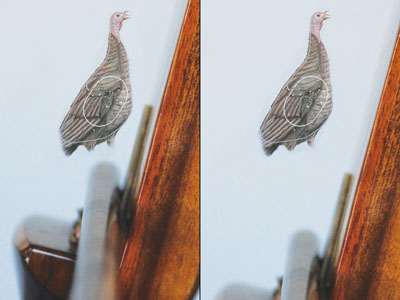
The smaller your gaps (left), the easier they are to utilize. Small gaps make precise aiming much easier.
Not only are larger gaps difficult to see due to deterioration in our peripheral vision, but our mind has a harder time identifying small inconsistencies in larger gaps than smaller ones. As an example, take a sheet of paper and cut two strips from it, one 2” wide and the other 2 1/8”. Put them both in a hat, pull one out, and give it a quick look. You may not be able to tell which one you grabbed without measuring it. Now do the same thing with strips that are 3/8” and ½”. I’ll bet you’ll know immediately which one you pulled from the hat.
That’s how our minds work with gap shooting. The smaller the gap, the easier it is to gauge with precision. This is really the result of percentages. When you’re dealing with a 2” strip of paper, a difference of 1/8” is only about 6%. That’s not much. But when you’re dealing with a ¼” strip of paper, that same 1/8” is now 50%. That’s a huge change that your mind can quickly identify.
With a small gap, the tip of your arrow may appear on the belly line of a deer at twenty yards. With a large gap, the tip of your arrow may be at its hoof. When you’re concentrating on a tuft of hair behind a deer’s shoulder, which gap is easier to see in your peripheral vision? If your aim is too high or low, your mind is more likely to notice with the small gap than the large one.
With my normal hunting setup, shooting split-fingered with my index finger in the corner of my mouth my point-on distance is ninety-five yards. By switching to three fingers under and anchoring substantially higher, that distance shrinks to forty yards. This takes my gaps at most hunting ranges from enormous and totally unusable to small enough for tremendous precision. By getting the tip of your arrow as close to your line of sight as possible, you allow your peripheral vision to see it clearly and your mind to aim it correctly. For bowhunting, big gaps are often a disaster waiting to happen.
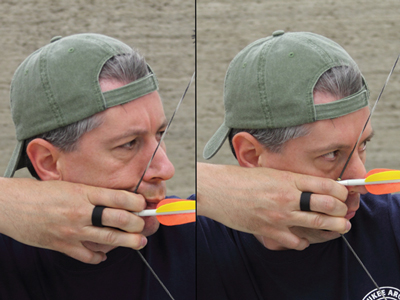
If you are going to utilize the tip of your arrow as an aiming reference for bowhunting, it’s in your best interests to consider switching to three fingers under and as high an anchor point as possible. This may require substantial change that will feel odd at first. For this reason, I suggest you get comfortable with any form changes before worrying about aiming and accuracy. Spend time shooting up close at what’s called a blank bale—a backstop without a target—ingraining your form changes until they become automatic. Once that happens, you can move onto the finer points of aiming with the tip of the arrow.
While I understand that this article didn’t give you everything you need to become a successful gap shooter, I’ve tried to provide the foundation for an extremely successful shooting method. Right now, we’ve figured out how to crawl and stand. In my next installment, we’ll go from walking to running like a champ by covering the ins and outs of aiming with what I consider the simplest, most effective version of gap shooting for bowhunters.


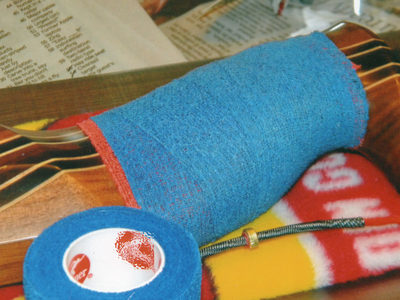
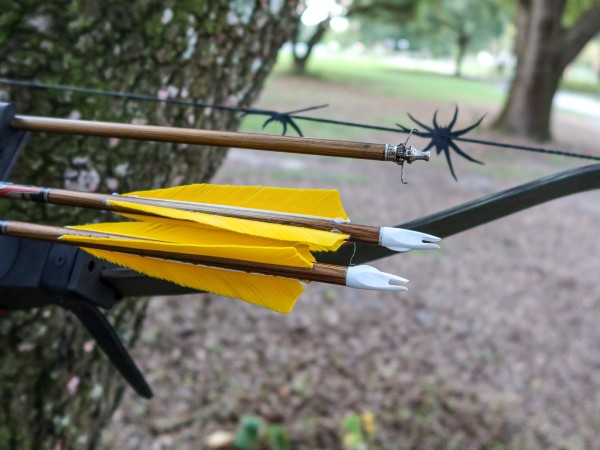


for me 3 fingers under the AIMING EYE. THAT;S THE GAP METHOD.OF ANY DISTANS is a lot better than split fingers….. THE ARROW UNDERE THE EYE WHERE IT BELONGS.
JERRY,BEEN SHOOTING LIKE THIS FOR YEARS IN COMPITITION OR HUNTING I USE THE DSME METHOD,,,,,,,,IT WORKS VERY WELL FOR ME…………..JERRY
T0 Jayson R. Wesbrock : Over the months, I’ve been anxiously been trying to piece together your shooting style and form. Please seriously consider writing an instruction book with pictures, captions etc. I would buy it. It would be easily be available to take to the shooting bales. Heck, Fred Asbell has written 4 hard cover books on his shooting style. Please write us a book or booklet on your style of shooting the bow!
I was wondering why Fred Bear and Howard Hill always used split finger and shot well? Especially Howard Hill.
Jason,
I really liked your valuable article on gap sohooting. I thinks it’s incumbent on us as traditional bowhunters to become very proficient with this type of equipment because I know from losing animals in field, which is heart wrenching. I can’t wait for part 2 Jason. I’ve been an instinctive shooter for 40 years and have dabbled in gap shooting by trial and error. But, I’m willing to dabble again with the right instructions.
Thanks you again for your valuable wisdom and sharing it with us.
Johnny Carroll
Great article. Can’t wait for the next installment.
Do you move your nocking point?
Great article,…While shooting split finger, anchoring middle finger at the corner of th mouth, and tilting the head i am point on at 30 Tp 40 yrds depending on my bow arrow combination. O and I can kill stuff running. Try that 3 under. There’s a reason the old timers shot spilt.
To Jerry:
Gotta love seeing people write in all CAPS and say thats where stuff belongs. The old timers, Bear, Asbell, Hill, Ferguson… they all shot split finger and used the same anchor point and didnt have to jump up and down saying thats were the arrow belongs. Truth is that whatever style works for your disposition. None of them will make you deadly overnight, and each person being different will have pros and cons for each style. The old timers were deadly accurate and shot they way they did for a reason. Ill stay with split finger and corner of the mouth anchor, its been good to me over the years. Nice article and nicely written. Only wish the comments were the same